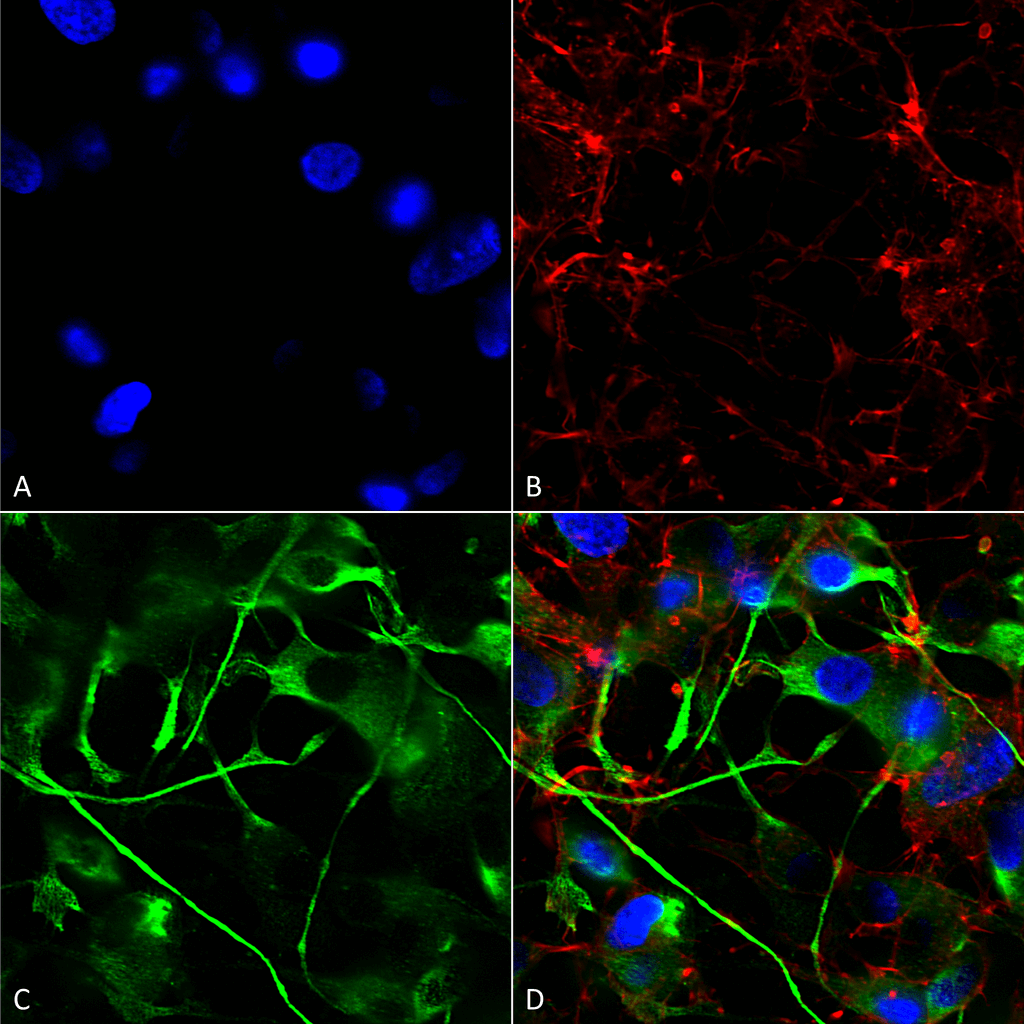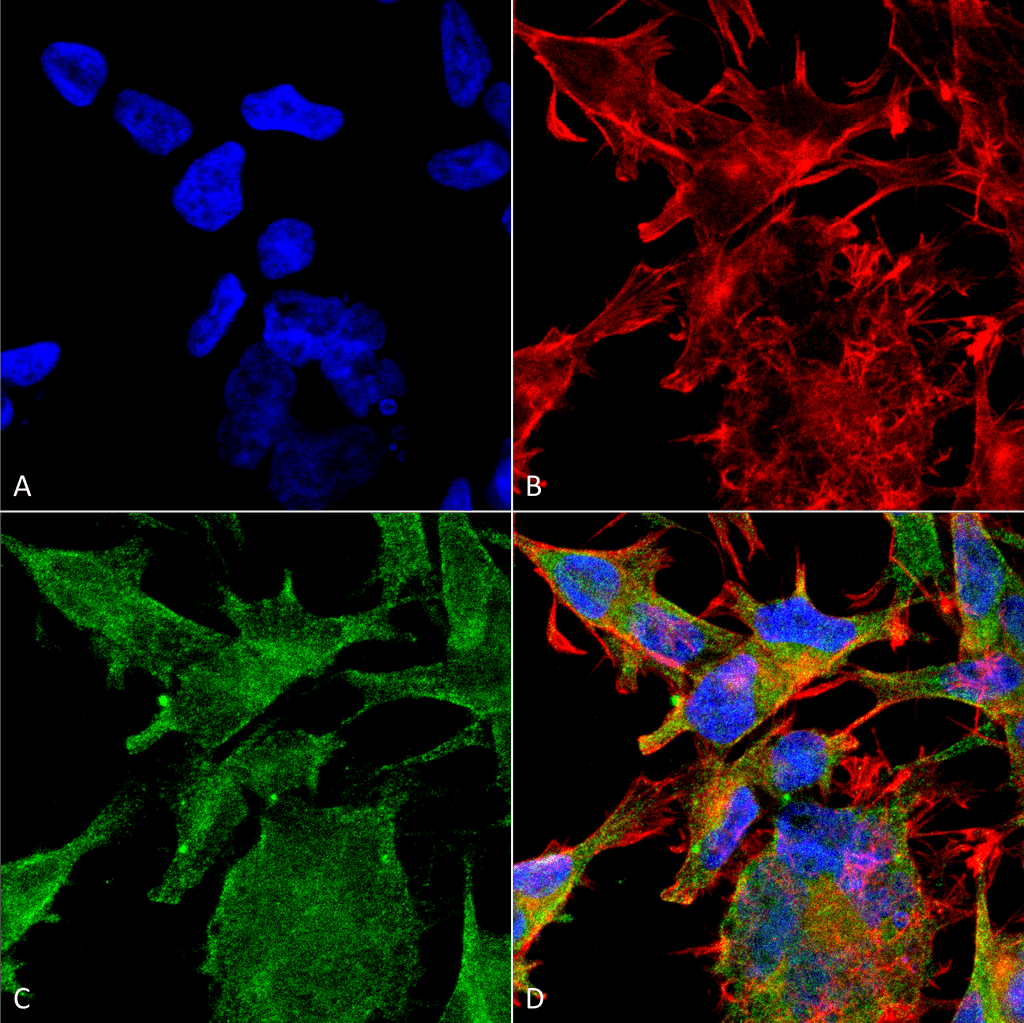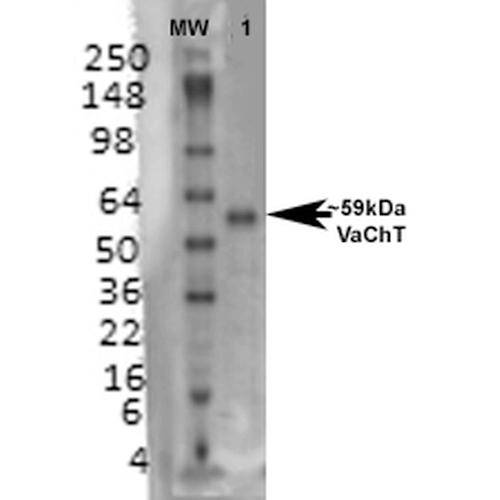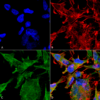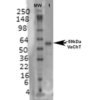Anti-VaChT Transporter Antibody (56513)
$466.00
| Host | Quantity | Applications | Species Reactivity | Data Sheet | |
|---|---|---|---|---|---|
| Mouse | 100ug | WB,IHC,ICC/IF | Human, Mouse, Rat |  |
SKU: 56513
Categories: Antibody Products, Neuroscience and Signal Transduction Antibodies, New Products, Products
Overview
Product Name Anti-VaChT Transporter Antibody (56513)
Description Anti-VAChT Transporter Mouse Monoclonal Antibody
Target VaChT Transporter
Species Reactivity Human, Mouse, Rat
Applications WB,IHC,ICC/IF
Host Mouse
Clonality Monoclonal
Clone ID S6-38
Isotype IgG1
Immunogen Synthetic peptide corresponding to aa 521-532 (CEDDYNYYYTRS) of human VAChT (accession no. NP_003046)
Properties
Form Liquid
Concentration 1.0 mg/mL
Formulation PBS, pH 7.4, 50% glycerol, 0.09% sodium azide.Purified by Protein G affinity chromatography.
Buffer Formulation Phosphate Buffered Saline
Buffer pH pH 7.4
Buffer Anti-Microbial 0.09% Sodium Azide
Buffer Cryopreservative 50% Glycerol
Format Purified
Purification Purified by Protein G affinity chromatography
Specificity Information
Specificity This antibody recognizes human, mouse, and rat VAChT.
Target Name Vesicular acetylcholine transporter
Target ID VaChT Transporter
Uniprot ID Q16572
Alternative Names VAChT, Solute carrier family 18 member 3
Gene Name SLC18A3
Sequence Location Membrane, Multi-pass membrane protein
Biological Function Involved in acetylcholine transport into synaptic vesicles. {PubMed:8071310}.
Research Areas Neuroscience
Background VAChT is a member of the vesicular amine transporter (VMAT) family. The encoded transmembrane protein transports acetylcholine into secretory vesicles for release into the extracellular space. Acetylcholine transport utilizes a proton gradient established by a vacuolar ATPase. This gene is located within the first intron of the choline acetyltransferase gene.
Application Images




Description Immunocytochemistry/Immunofluorescence analysis using Mouse Anti-VAChT Monoclonal Antibody, Clone S6-38 (56513). Tissue: Neuroblastoma cells (SH-SY5Y). Species: Human. Fixation: 4% PFA for 15 min. Primary Antibody: Mouse Anti-VAChT Monoclonal Antibody (56513) at 1:200 for overnight at 4°C with slow rocking. Secondary Antibody: AlexaFluor 488 at 1:1000 for 1 hour at RT. Counterstain: Phalloidin-iFluor 647 (red) F-Actin stain; Hoechst (blue) nuclear stain at 1:800, 1.6mM for 20 min at RT. (A) Hoechst (blue) nuclear stain. (B) Phalloidin-iFluor 647 (red) F-Actin stain. (C) VAChT Antibody (D) Composite.

Description Immunocytochemistry/Immunofluorescence analysis using Mouse Anti-VAChT Monoclonal Antibody, Clone S6-38 (56513). Tissue: Neuroblastoma cell line (SK-N-BE). Species: Human. Fixation: 4% Formaldehyde for 15 min at RT. Primary Antibody: Mouse Anti-VAChT Monoclonal Antibody (56513) at 1:100 for 60 min at RT. Secondary Antibody: Goat Anti-Mouse ATTO 488 at 1:200 for 60 min at RT. Counterstain: Phalloidin Texas Red F-Actin stain; DAPI (blue) nuclear stain at 1:1000, 1:5000 for 60 min at RT, 5 min at RT. Localization: Membrane. Magnification: 60X. (A) DAPI (blue) nuclear stain. (B) Phalloidin Texas Red F-Actin stain. (C) VAChT Antibody. (D) Composite.

Description Western Blot analysis of Rat brain membrane lysate showing detection of VAChT protein using Mouse Anti-VAChT Monoclonal Antibody, Clone S6-38 (56513). Primary Antibody: Mouse Anti-VAChT Monoclonal Antibody (56513) at 1:1000.
Handling
Storage This product is stable for at least 1 year at -20°C. Freeze in multiple aliquots to avoid repeated freeze-thaw cycles.
Dilution Instructions Dilute in PBS or medium that is identical to that used in the assay system.
Application Instructions Immunoblotting: use at 1-10ug/mL. A band of 55kDa is detected. The molecular weight of glycosylated VAChT is 70kDa.
Immunohistochemistry: use at 1-10ug/mL.
These are recommended concentrations.
Enduser should determine optimal concentrations for their applications.
Positive control: rat brain
Immunohistochemistry: use at 1-10ug/mL.
These are recommended concentrations.
Enduser should determine optimal concentrations for their applications.
Positive control: rat brain
References & Data Sheet
Data Sheet  Download PDF Data Sheet
Download PDF Data Sheet
 Download PDF Data Sheet
Download PDF Data Sheet

